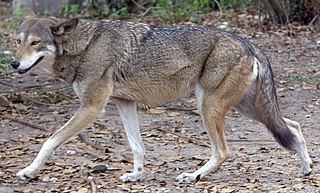Related Research Articles

The coyote is a species of canine native to North America. It is smaller than its close relative, the wolf, and slightly smaller than the closely related eastern wolf and red wolf. It fills much of the same ecological niche as the golden jackal does in Eurasia. The coyote is larger and more predatory and was once referred to as the American jackal by a behavioral ecologist. Other historical names for the species include the prairie wolf and the brush wolf.

The red wolf is a canine native to the southeastern United States. Its size is intermediate between the coyote and gray wolf.

The wolf, also known as the gray wolf or grey wolf, is a large canine native to Eurasia and North America. More than thirty subspecies of Canis lupus have been recognized, and gray wolves, as colloquially understood, comprise non-domestic/feral subspecies. The wolf is the largest extant member of the family Canidae. It is also distinguished from other Canis species by its less pointed ears and muzzle, as well as a shorter torso and a longer tail. The wolf is nonetheless related closely enough to smaller Canis species, such as the coyote and the golden jackal, to produce fertile hybrids with them. The banded fur of a wolf is usually mottled white, brown, gray, and black, although subspecies in the arctic region may be nearly all white.

Canis is a genus of the Caninae which includes multiple extant species, such as wolves, dogs, coyotes, and golden jackals. Species of this genus are distinguished by their moderate to large size, their massive, well-developed skulls and dentition, long legs, and comparatively short ears and tails.

Rodney Adam Coronado is an American animal rights and environmental activist known for his militant direct actions in the late 1980s and 1990s. Born to Pascua Yaqui indigenous ancestry, Coronado loved nature as a child and became an activist as a teenager. As part of the Sea Shepherd Conservation Society, he sunk two whaling ships and destroyed Iceland's sole whale-processing facility in 1986. He led the Animal Liberation Front's Operation Bite Back campaign against the fur industry and its supporting institutions in the early 1990s, which was involved in multiple firebombings. Following an attack on a Michigan State University mink research center in early 1992, Coronado was jailed for nearly five years. He later admitted to being the sole perpetrator. The 1992 federal Animal Enterprise Protection Act was created in response to his actions. The operation continued with a focus on liberating animals rather than property destruction. Coronado also worked with Earth First.
A lone wolf attack, or lone actor attack, is a particular kind of mass murder, committed in a public setting by an individual who plans and commits the act on their own. In the United States, such attacks are usually committed with firearms. In other countries, knives are sometimes used to commit mass stabbings. Although definitions vary, most databases require a minimum of four victims for the event to be considered a mass murder.

The Grey Wolves, officially known as Idealist Hearths, is a Turkish far-right organization and movement affiliated with the Nationalist Movement Party (MHP). Commonly described as ultranationalistic, Islamistic, and neo-fascist, it's a youth organization that has been characterized as MHP's paramilitary or militant wing. Its members deny its political nature and claim it to be a cultural and educational foundation, as per its full official name: Ülkü Ocakları Eğitim ve Kültür Vakfı.

Wolf hunting is the practice of hunting gray wolves (Canis lupus) or other species of wolves. Wolves are mainly hunted for sport, for their skins, to protect livestock and, in some rare cases, to protect humans. Wolves have been actively hunted since 8,000 to 10,000 years ago, when they first began to pose a threat to livestock vital for the survival of Neolithic human communities. Historically, the hunting of wolves was a huge capital- and manpower-intensive operation. The threat wolves posed to both livestock and people was considered significant enough to warrant the conscription of whole villages under threat of punishment, despite the disruption of economic activities and reduced taxes. The hunting of gray wolves, while originally actively endorsed in many countries, has become a controversial issue in some nations. Opponents see it as cruel, unnecessary and based on misconceptions, while proponents argue that it is vital for the conservation of game herds and as pest control.
Wolf reintroduction involves the reintroduction of a portion of grey wolves in areas where native wolves have been extirpated. More than 30 subspecies of Canis lupus have been recognized, and grey wolves, as colloquially understood, comprise nondomestic/feral subspecies. Reintroduction is only considered where large tracts of suitable wilderness still exist and where certain prey species are abundant enough to support a predetermined wolf population.

The Iberian wolf, is a subspecies of grey wolf. It inhabits the northwest of the Iberian Peninsula, which includes northwestern Spain and northern Portugal. It is home to 2,200-2,700 wolves which have been isolated from mixing with other wolf populations for over a century. They form the largest wolf population in Western Europe.

The Wolves of Ashta were a pack of 6 man-eating Indian wolves which between the last quarter of 1985 to January 1986, killed 17 children in Ashta, Madhya Pradesh, a town in the Sehore district. The pack consisted of two adult males, one adult female, one subadult female and two pups. Initially thought to be a lone animal, the fear caused by the wolves had serious repercussions on the life of the villagers within their hunting range. Farmers became too frightened to leave their huts, leaving crops out of cultivation, and several parents prohibited their children from attending school, for fear that the man-eaters would catch them on the way. So great was their fear, that some village elders doubted the man-eaters were truly wolves at all, but Shaitans. With the exception of the pups, which were adopted by Pardhi tribesmen, all wolves were killed by hunters and forest officials.

OR-7, also known as Journey, was a male gray wolf that was electronically tracked as he migrated from the Wallowa Mountains in the northeastern corner of the U.S. state of Oregon to the southern Cascade Range. After the wolf dispersed from his natal pack in 2011, he wandered generally southwest for more than 1,000 miles (1,600 km) through Oregon and northern California. He was the first confirmed wild wolf in western Oregon since 1947 and the first in California since 1924.

The African wolf is a canine native to North Africa, West Africa, the Sahel, northern East Africa, and the Horn of Africa. It is listed as least concern on the IUCN Red List. In the Atlas Mountains, it was sighted in elevations as high as 1,800 m (5,900 ft). It is primarily a predator, targeting invertebrates and mammals as large as gazelle fawns, though larger animals are sometimes taken. Its diet also includes animal carcasses, human refuse, and fruit. The African wolf is a monogamous and territorial species; offspring remain with the family to assist in raising their parents' younger pups.

The repopulation of wolves in California was recognized in late December 2011, when OR-7, a male gray wolf from Oregon, became the first confirmed wild wolf in California since 1924, when wolves were considered extirpated from the state. The first resident wolf pack was confirmed in 2015, after two adults migrated from Oregon and had five pups. Additional wolves have been tracked entering the state, as the Cascade Range, which wolves have repopulated in Oregon, extends south into northern California. In 2021, the state had at least two wolf packs with pups for the first time in over a hundred years. It is likely that other uncollared wolves are dispersing through portions of their historic habitat in California.
926F (Spitfire) was a wild she-wolf popular with visitors of Yellowstone National Park, who was killed about a mile outside the park boundary by a hunter when she crossed from the park into Montana, where the hunting of wolves was legal.

Wolfwalkers is a 2020 animated fantasy adventure film directed by Tomm Moore and Ross Stewart. The film is the third and final installment in Moore's "Irish Folklore Trilogy", following his previous films The Secret of Kells (2009) and Song of the Sea (2014). An international co-production led by Cartoon Saloon and Mélusine Productions, the film premiered at the 2020 Toronto International Film Festival on September 12 and was released theatrically in the United Kingdom on October 26, in the United States and Canada on November 13, and in Ireland on December 2. It was released digitally on Apple TV+ on December 11, 2020, to critical acclaim.
O-Six (2006–2012), also known as 832F or "The 06 Female", was a female gray wolf, whose death by hunting just outside the protected area of Yellowstone National Park stirred debate about the hunting and protection of wolves in Wyoming, Montana and Idaho. The bestselling book American Wolf focused on O-Six's life and on conservation policies in the Yellowstone region.
The repopulation of wolves in Midwestern United States has occurred naturally as the gray wolf has expanded its territory after being nearly extirpated from the conterminous United States. The Midwestern states of Michigan, Minnesota, and Wisconsin are estimated to have 4,400 wolves. The western Great Lakes region they inhabit includes the forested areas of these states, along with the Canadian provinces of Manitoba and Ontario. In 1978, wolves were protected under the federal Endangered Species Act as it was determined that they were in danger of going extinct and needed protection to aid their recovery. Management under the Act allowed the remaining wolves in Minnesota to flourish and repopulate northern Wisconsin and the Upper Peninsula of Michigan. Wolves were removed from federal protection in January 2021 with management authority remaining with state and tribal authorities. Management plans guide each state’s decisions about wolf regulations for hunting, trapping, and culling along with population monitoring, and livestock damage control.
References
- Binversie, Ben; Hurbanis, Jack (May 17, 2021). "'Operation Wolf Patrol' Documentary Follows Wolf Activists in the Field". WUWM. Retrieved November 24, 2021.
- Blakeslee, Nate (July 27, 2021). "'An abomination': the story of the massacre that killed 216 wolves". The Guardian . ISSN 0261-3077.
- Brown, Alleen; Knefel, John (September 1, 2018). "The FBI Tried to Use the #MeToo Moment to Pressure an Environmental Activist Into Becoming an Informant". The Intercept . Retrieved November 14, 2021.
- Elgin, Beckie (2016). "Hounding the Hunters". Earth Island Journal. 30 (4): 30–36. ISSN 1041-0406. EBSCOhost 111114674 ProQuest 1748580823.
- Rietmulder, Michael (November 2, 2015). "How Wolf Patrol's Rod Coronado is pissing off Wisconsin hunters". City Pages . Archived from the original on August 30, 2017. Retrieved August 30, 2017.